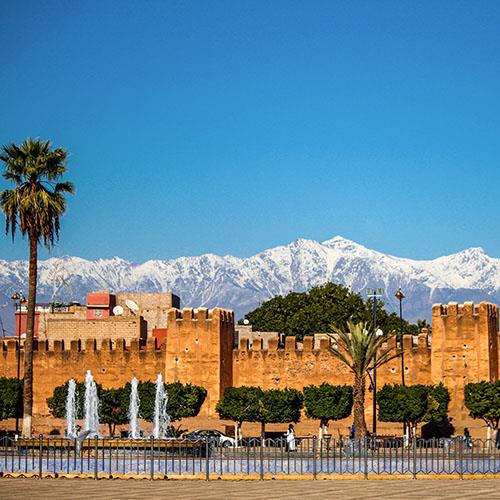


The Atlas Mountains are broken up into four smaller mountain ranges located in central and eastern Morocco. The Anti-Atlas and Saharan Atlas ranges are the southernmost and eventually meet the High Atlas Mountains, where Mount Toubkal, Morocco`s highest point, is located. The High Atlas range leads north and east toward the opposite end of Morocco, meeting the Middle Atlas range. The cities of the Atlas ranges tend to be situated in the foothills and nearby river valleys, allowing for easy exploration of the nearby peaks. The Atlas ranges stretch across 38,000 square miles, covering more than 20% of the kingdom.
Please note we do not offer hotels or other activities in Aït Benhaddou, Boumalne Dadès, Rissani, and Taroudant at this time, but you can explore them by choosing any of them as additions on any of the packages listed below.
Casablanca, the `Gateway to the Maghreb`, is the largest city in Morocco and the country`s commercial and social epicenter. To understand Morocco, you must visit Casablanca, its heart, where French, Arab, Berber, and many other cultures came together to create a breathtaking and historic cosmopolitan city.
Rabat is the capital of the Kingdom of Morocco. It is built on a cliffside overlooking the Atlantic coast, across from its sister city Salé. Noteworthy sights include the Royal Palace, the primary residence of King Mohammed VI; and Hassan Tower, a solitary minaret built in the late 1100s for a mosque that was never completed.
Marrakech boasts a long history tied to the tragedies and triumphs of the sultans and kings of Morocco. The heart of the fortified Old City, The Medina, is filled with historical buildings and great shopping opportunities. The Medina, Menara Gardens, and Agdal Gardens have all been named UNESCO World Heritage Sites.
Fez is most famous for its ancient walled city, often compared to the walled city of Jerusalem. The immense medina of Fes-l-Bali (the old city) is a huge labyrinth. Lose yourself in the myriad markets, and find your way out once you have had enough of all the sights, sounds, and smells that will overwhelm your senses.
Chefchaouen, the enchanting `blue city` nestled in Morocco`s Rif Mountains, is world-renowned for its breathtakingly beautiful blue-washed buildings, its Kasbah, and its Grand Mosque. The sizable Medina is a charming maze of streets and alleyways with some of the best shopping you will find in Morocco.
Tangier is a fascinating city with a mysterious air, an interesting history, breathtaking views, unspoiled beaches, and friendly people. It is the perfect blend between African, Spanish and French influences. Climb on the top of the hill on which Tangier is built; you will have the chance to see two continents at once.
Morocco is home to nine UNESCO World Heritage Sites scattered throughout the kingdom. The sites include ancient Roman cities, capitals of dynasties, fortified villages and towns, beautiful medinas, and architecture that mixes Moroccan and colonial styles brought to Africa by the French, Spanish, and Portuguese.
The sultans and kings of Morocco built an imperial tradition over a millennium, leaving behind an impressive legacy befitting the world`s most enduring royal family. There were four cities that claimed the title of capital of the Kingdom of Morocco (Rabat, Marrakech, Fez, and Meknes), each with their own beauty, charm, and story to tell.
Many travelers who visit Morocco get to see Casablanca and Marrakech, but what about the hidden gems? These towns and cities are located near the sea, in the mountains, and in valleys. Some are close to big cities, some are in literal oases, and others are outposts on the Saharan steppes.
The Moroccan coast stretches on for 1,140 miles, from Tarfaya in the south to Saïdia in the northeast. Morocco is home to some of the best surfing and water sport opportunities in the world. Many of Morocco`s large cities and vacation destinations are situated along the Atlantic and Mediterranean coasts.
The Sahara Desert`s northwesternmost sands lie in Morocco. The sand dunes of Erg Chebbi and Erg Chigaga transition to valleys which eventually meet the Atlas Mountains. Much of the Moroccan Sahara is considered a frontier, even today, and it is a captivating and exciting place, where you can visit cities and oases and ride a camel in the desert in the same trip.
Colonial powers, such as the French, Spanish, and Portuguese, have ruled portions of Morocco since the 15th century, bringing with them their customs, culinary traditions, architecture, and cultures. Now intermingled with Arabic and Berber cultures, the Morocco tourists see today has a more European feel than other former colonies in North Africa.